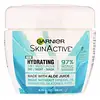What's inside
What's inside
 Key Ingredients
Key Ingredients

 Benefits
Benefits

 Concerns
Concerns

 Ingredients Side-by-side
Ingredients Side-by-side

Water
Skin ConditioningGlycerin
HumectantAloe Barbadensis Leaf Juice
Skin ConditioningDicaprylyl Ether
EmollientAlcohol Denat.
AntimicrobialCaprylic/Capric Triglyceride
MaskingZea Mays Starch
AbsorbentPolyglyceryl-3 Methylglucose Distearate
EmulsifyingStearyl Alcohol
EmollientGlyceryl Stearate Se
EmulsifyingCarbomer
Emulsion StabilisingSalicylic Acid
MaskingCaprylyl Glycol
EmollientTocopherol
AntioxidantParfum
MaskingSodium Hydroxide
BufferingXanthan Gum
EmulsifyingSodium Phytate
Glycine Soja Oil
EmollientCitric Acid
BufferingPotassium Sorbate
PreservativeSodium Benzoate
MaskingWater, Glycerin, Aloe Barbadensis Leaf Juice, Dicaprylyl Ether, Alcohol Denat., Caprylic/Capric Triglyceride, Zea Mays Starch, Polyglyceryl-3 Methylglucose Distearate, Stearyl Alcohol, Glyceryl Stearate Se, Carbomer, Salicylic Acid, Caprylyl Glycol, Tocopherol, Parfum, Sodium Hydroxide, Xanthan Gum, Sodium Phytate, Glycine Soja Oil, Citric Acid, Potassium Sorbate, Sodium Benzoate
Water
Skin ConditioningButylene Glycol
HumectantGlycerin
HumectantNiacinamide
SmoothingCyclopentasiloxane
EmollientIsopropyl Isostearate
EmollientDimethicone
EmollientPolymethylsilsesquioxane
Morus Alba Root Extract
BleachingLilium Candidum Flower Extract
Skin ConditioningLonicera Japonica Flower Extract
Skin ConditioningSodium Ascorbyl Phosphate
AntioxidantTocopheryl Acetate
AntioxidantGlucosyl Hesperidin
HumectantPanthenol
Skin ConditioningAcrylates/C10-30 Alkyl Acrylate Crosspolymer
Emulsion StabilisingDimethiconol
EmollientDimethicone Crosspolymer
Emulsion StabilisingAminomethyl Propanol
BufferingPhenoxyethanol
PreservativeDMDM Hydantoin
PreservativeEthylhexyl Salicylate
UV AbsorberBenzyl Alcohol
PerfumingCetyl Alcohol
EmollientIodopropynyl Butylcarbamate
PreservativeDisodium EDTA
Parfum
MaskingWater, Butylene Glycol, Glycerin, Niacinamide, Cyclopentasiloxane, Isopropyl Isostearate, Dimethicone, Polymethylsilsesquioxane, Morus Alba Root Extract, Lilium Candidum Flower Extract, Lonicera Japonica Flower Extract, Sodium Ascorbyl Phosphate, Tocopheryl Acetate, Glucosyl Hesperidin, Panthenol, Acrylates/C10-30 Alkyl Acrylate Crosspolymer, Dimethiconol, Dimethicone Crosspolymer, Aminomethyl Propanol, Phenoxyethanol, DMDM Hydantoin, Ethylhexyl Salicylate, Benzyl Alcohol, Cetyl Alcohol, Iodopropynyl Butylcarbamate, Disodium EDTA, Parfum
 Reviews
Reviews

Ingredients Explained
These ingredients are found in both products.
Ingredients higher up in an ingredient list are typically present in a larger amount.
Glycerin is already naturally found in your skin. It helps moisturize and protect your skin.
A study from 2016 found glycerin to be more effective as a humectant than AHAs and hyaluronic acid.
As a humectant, it helps the skin stay hydrated by pulling moisture to your skin. The low molecular weight of glycerin allows it to pull moisture into the deeper layers of your skin.
Hydrated skin improves your skin barrier; Your skin barrier helps protect against irritants and bacteria.
Glycerin has also been found to have antimicrobial and antiviral properties. Due to these properties, glycerin is often used in wound and burn treatments.
In cosmetics, glycerin is usually derived from plants such as soybean or palm. However, it can also be sourced from animals, such as tallow or animal fat.
This ingredient is organic, colorless, odorless, and non-toxic.
Glycerin is the name for this ingredient in American English. British English uses Glycerol/Glycerine.
Learn more about GlycerinParfum is a catch-all term for an ingredient or more that is used to give a scent to products.
Also called "fragrance", this ingredient can be a blend of hundreds of chemicals or plant oils. This means every product with "fragrance" or "parfum" in the ingredients list is a different mixture.
For instance, Habanolide is a proprietary trade name for a specific aroma chemical. When used as a fragrance ingredient in cosmetics, most aroma chemicals fall under the broad labeling category of “FRAGRANCE” or “PARFUM” according to EU and US regulations.
The term 'parfum' or 'fragrance' is not regulated in many countries. In many cases, it is up to the brand to define this term.
For instance, many brands choose to label themselves as "fragrance-free" because they are not using synthetic fragrances. However, their products may still contain ingredients such as essential oils that are considered a fragrance by INCI standards.
One example is Calendula flower extract. Calendula is an essential oil that still imparts a scent or 'fragrance'.
Depending on the blend, the ingredients in the mixture can cause allergies and sensitivities on the skin. Some ingredients that are known EU allergens include linalool and citronellol.
Parfum can also be used to mask or cover an unpleasant scent.
The bottom line is: not all fragrances/parfum/ingredients are created equally. If you are worried about fragrances, we recommend taking a closer look at an ingredient. And of course, we always recommend speaking with a professional.
Learn more about ParfumWater. It's the most common cosmetic ingredient of all. You'll usually see it at the top of ingredient lists, meaning that it makes up the largest part of the product.
So why is it so popular? Water most often acts as a solvent - this means that it helps dissolve other ingredients into the formulation.
You'll also recognize water as that liquid we all need to stay alive. If you see this, drink a glass of water. Stay hydrated!
Learn more about Water